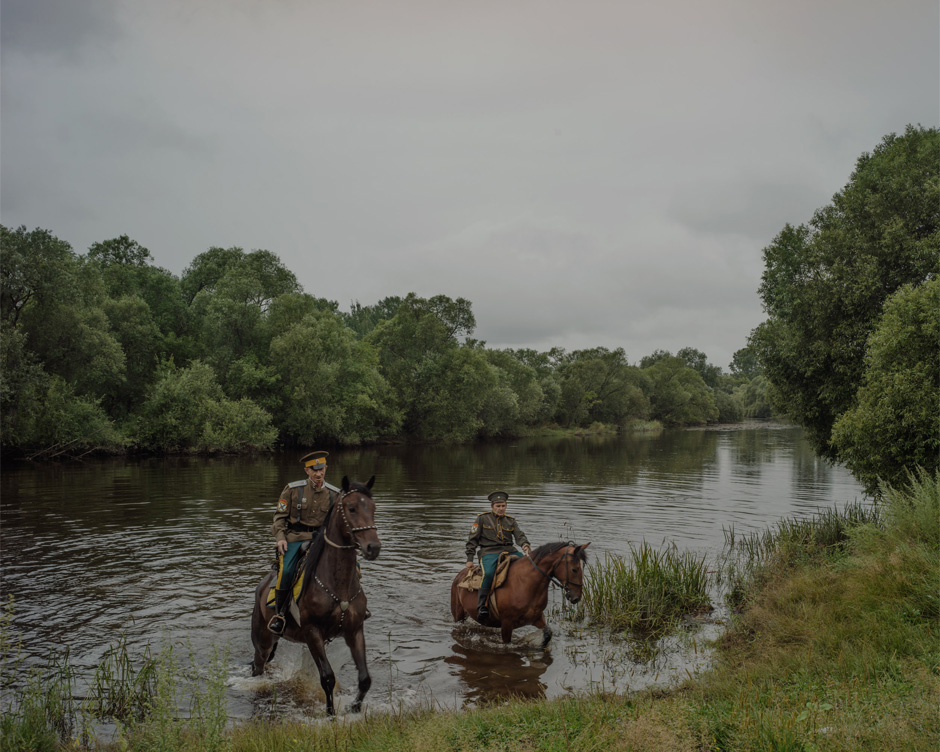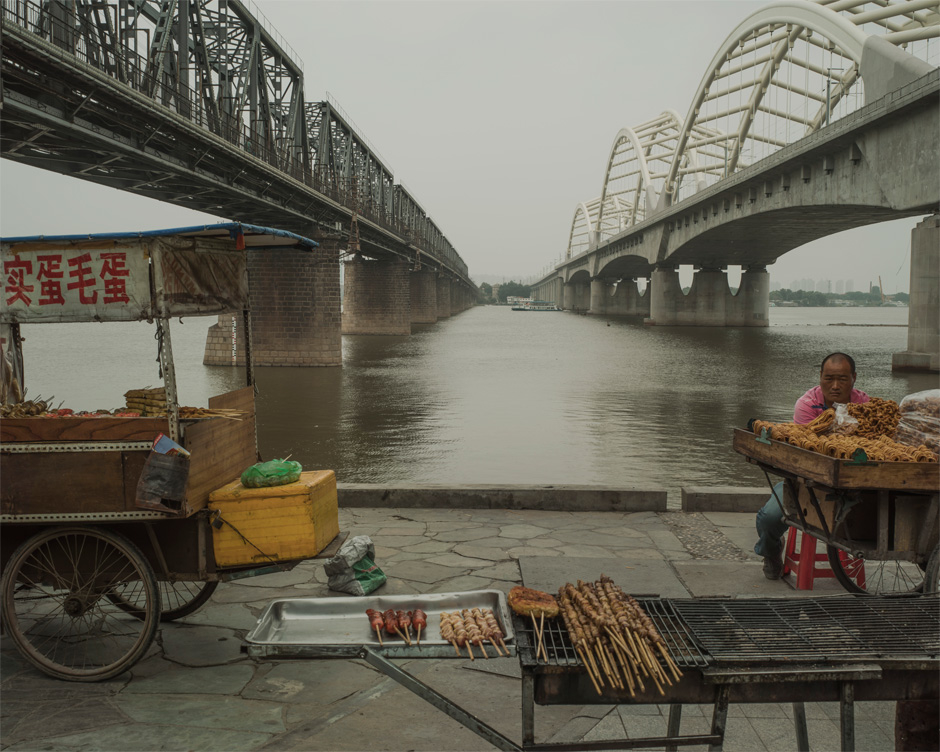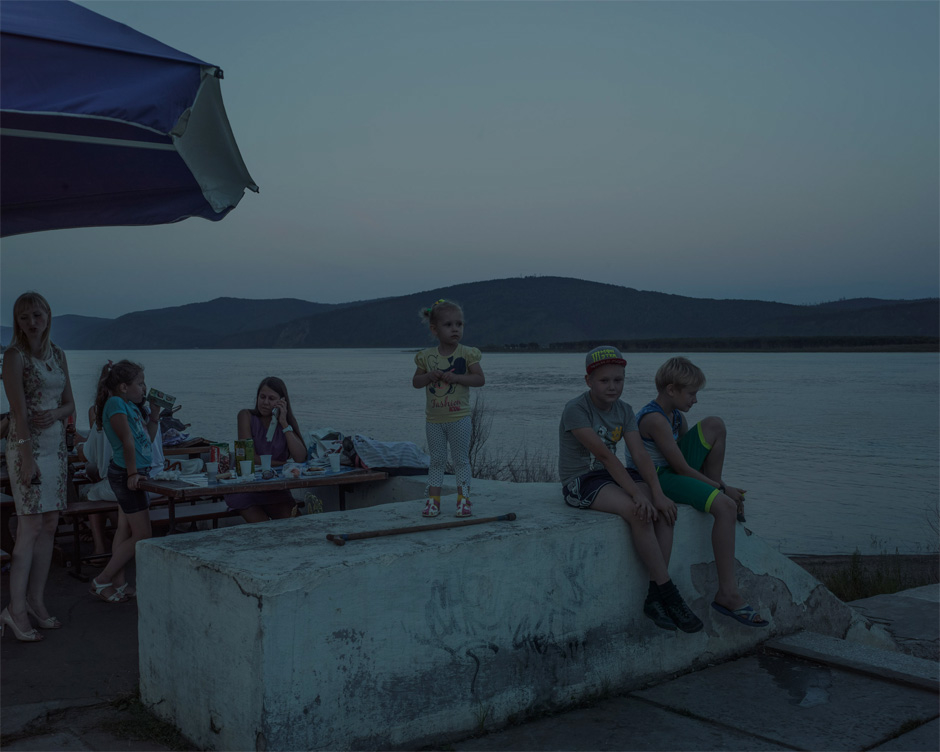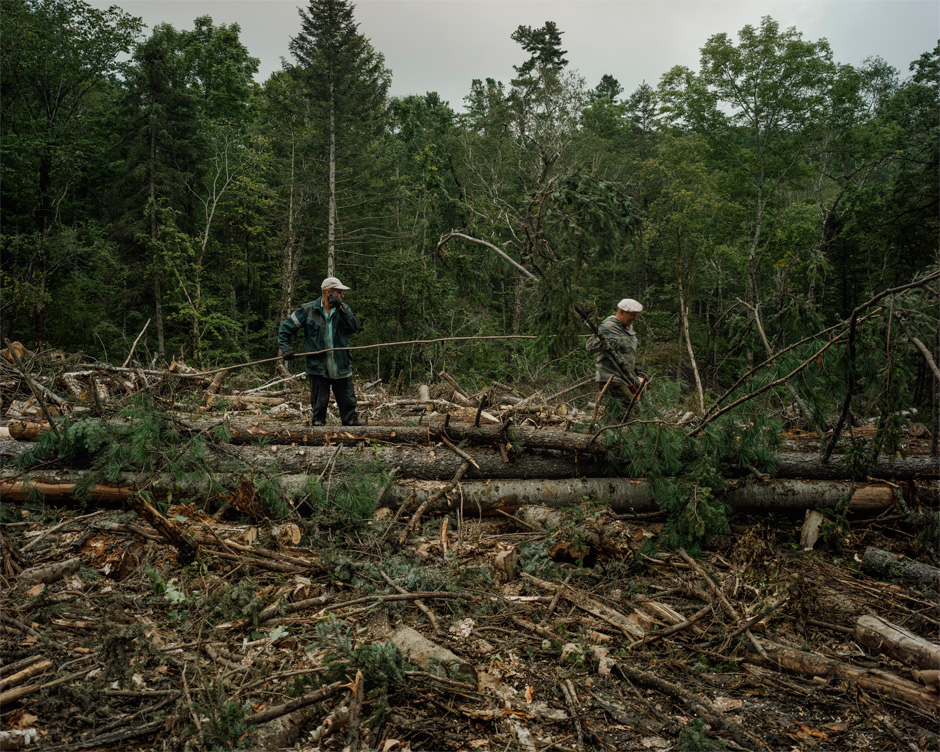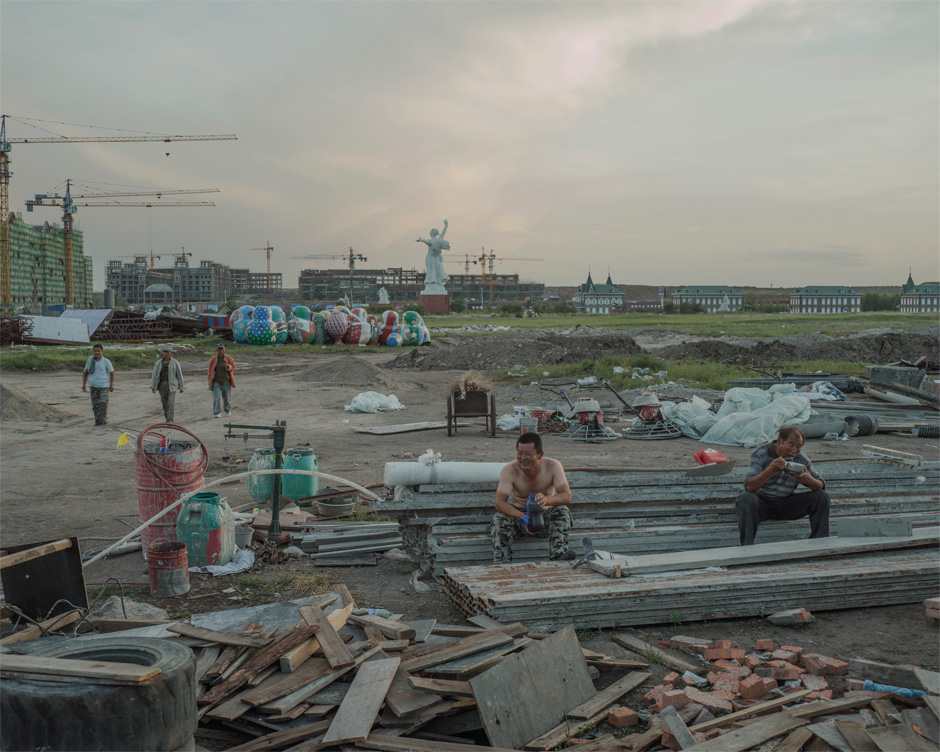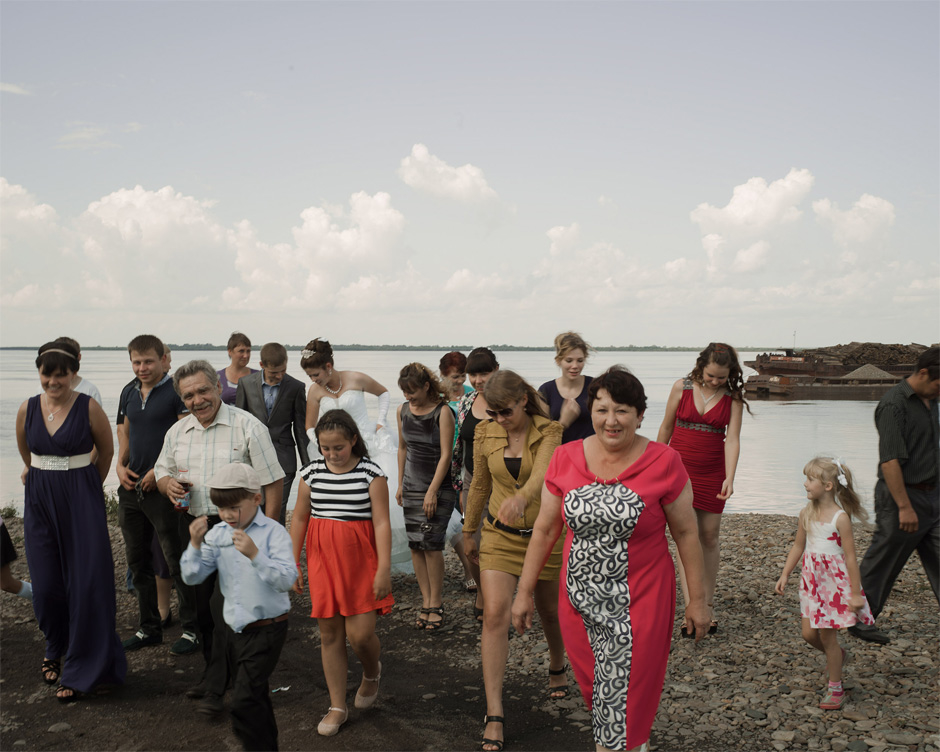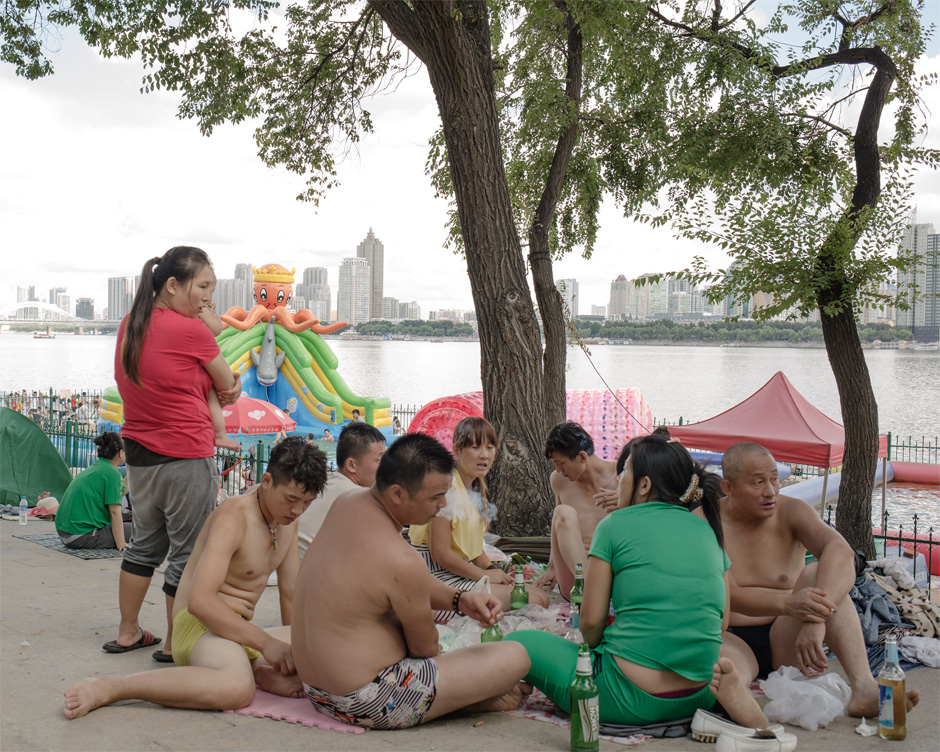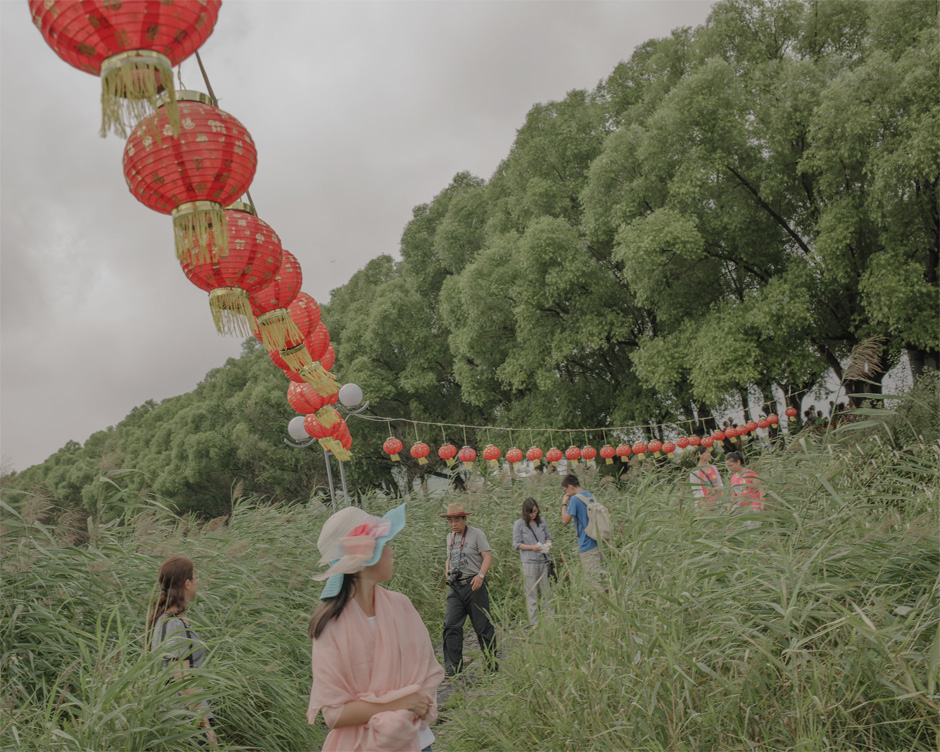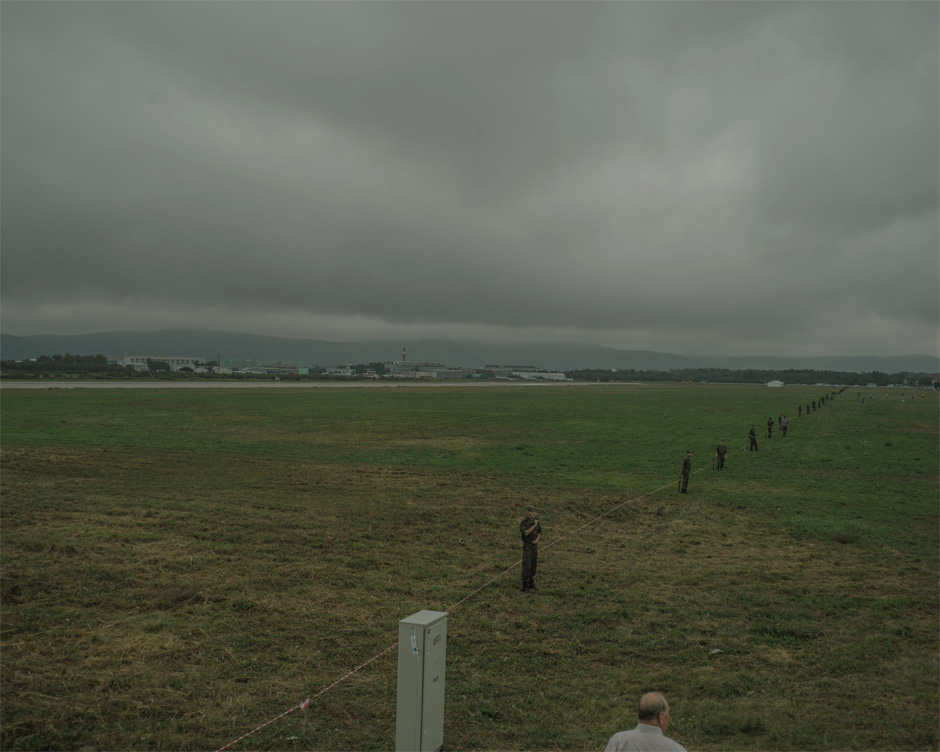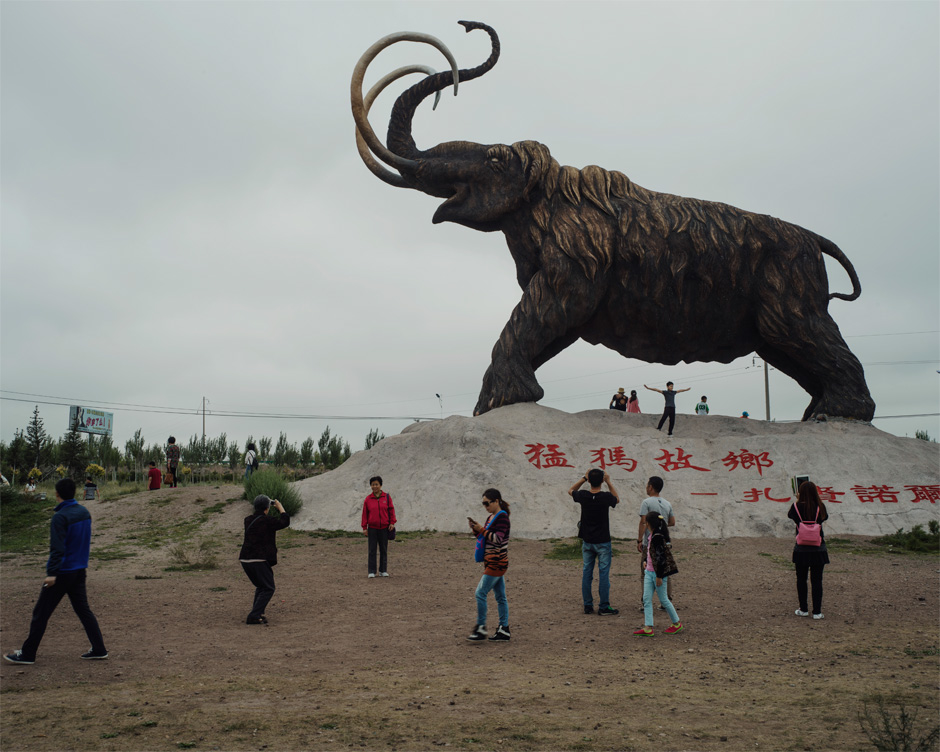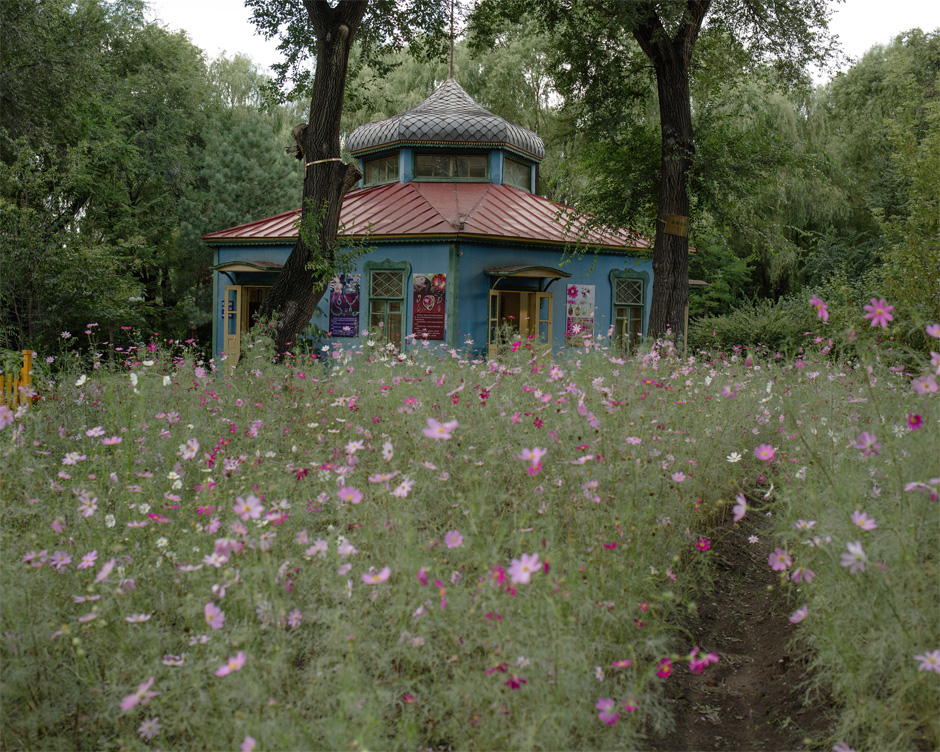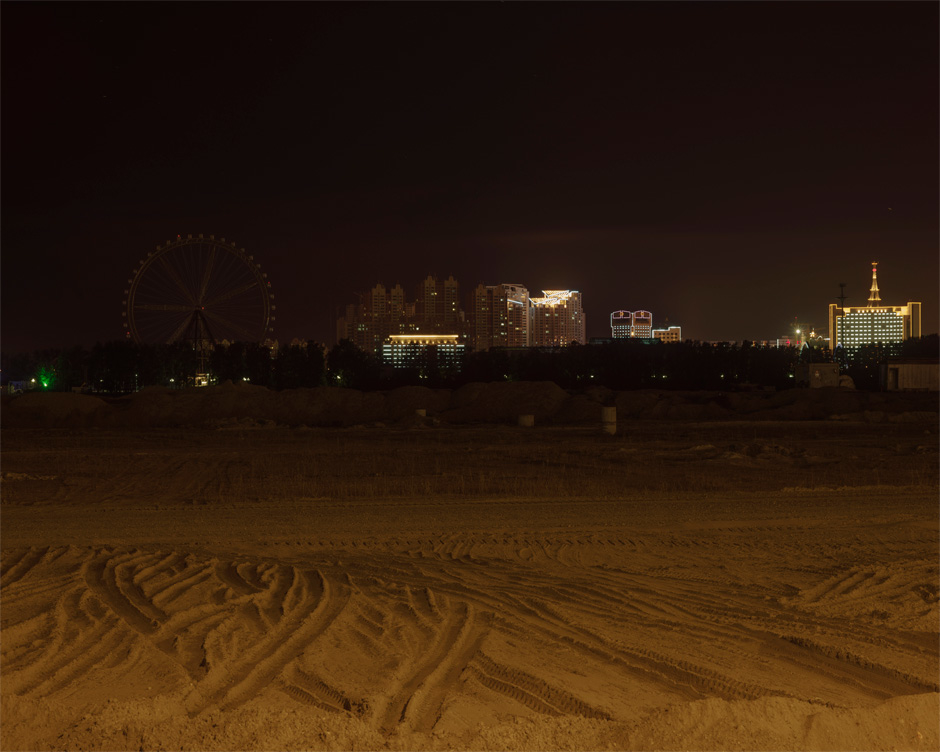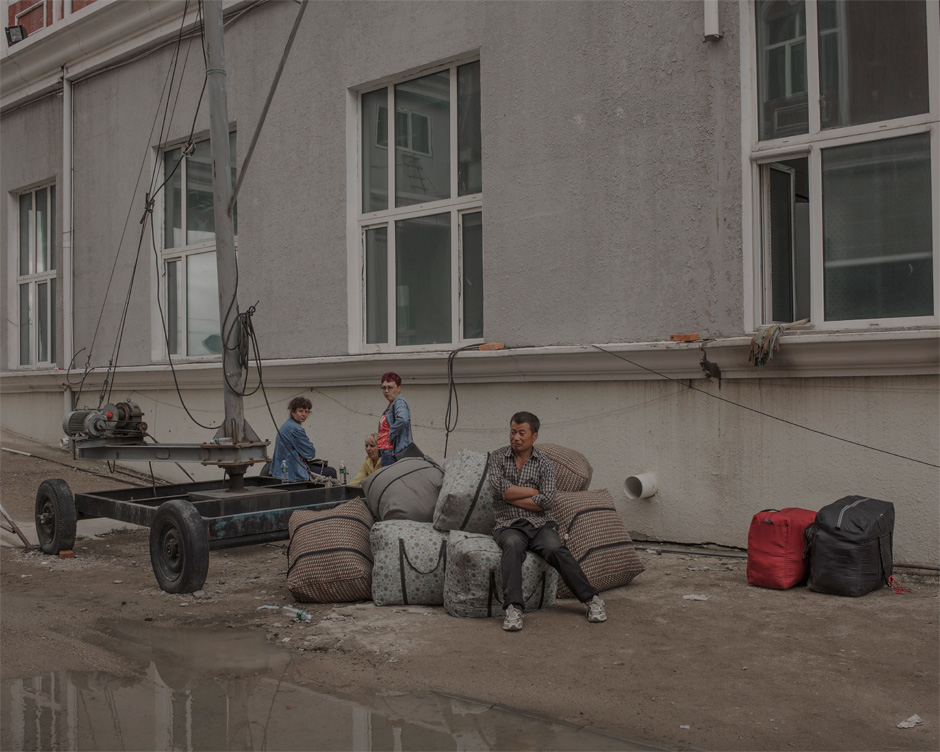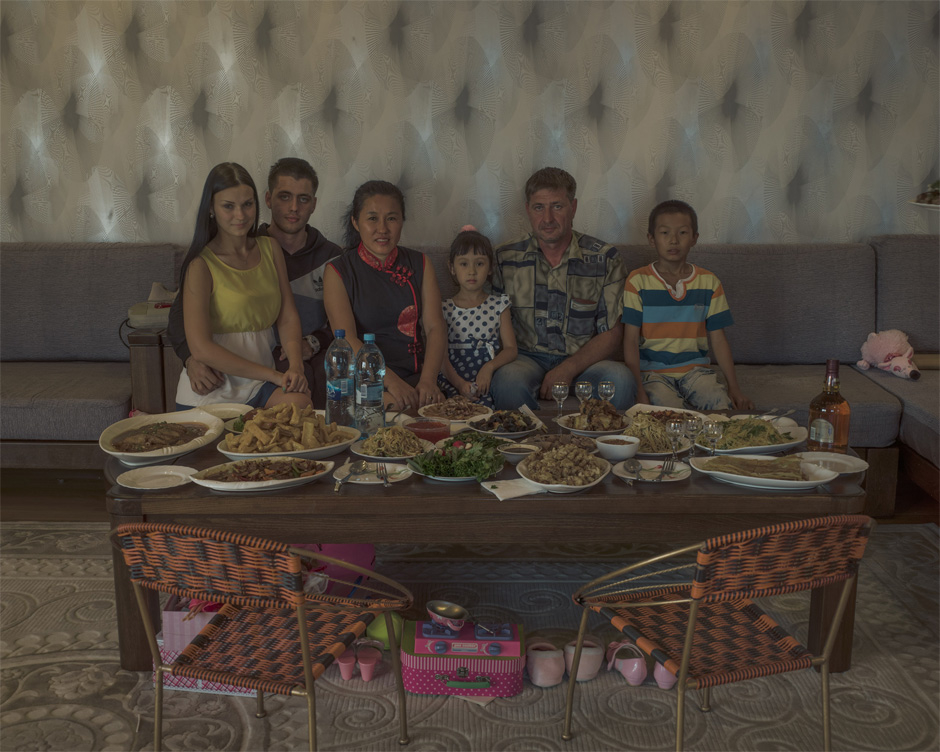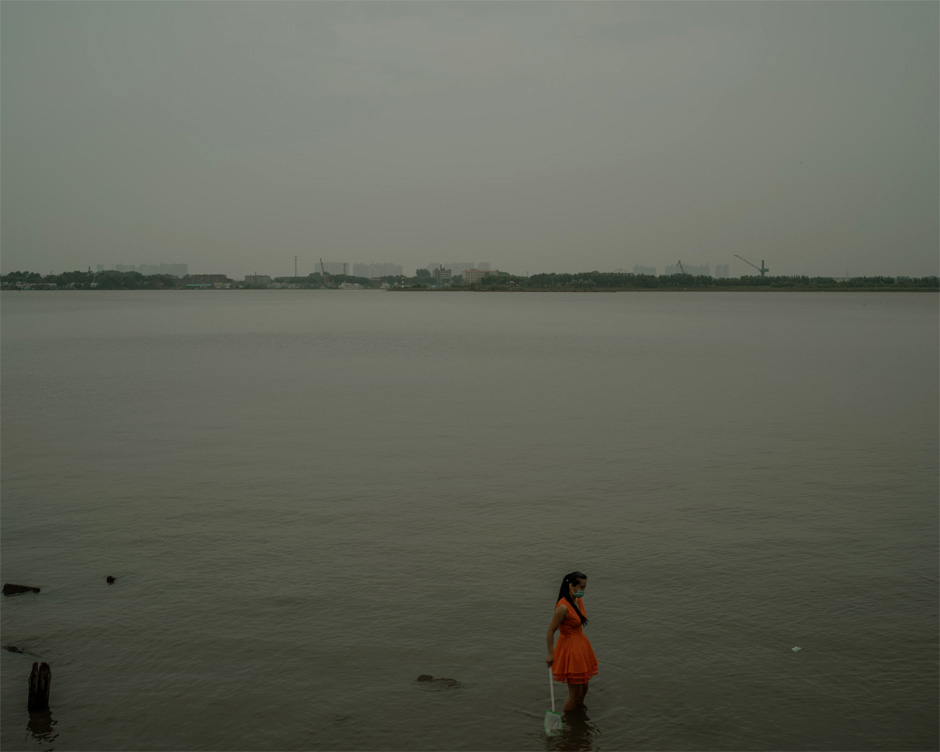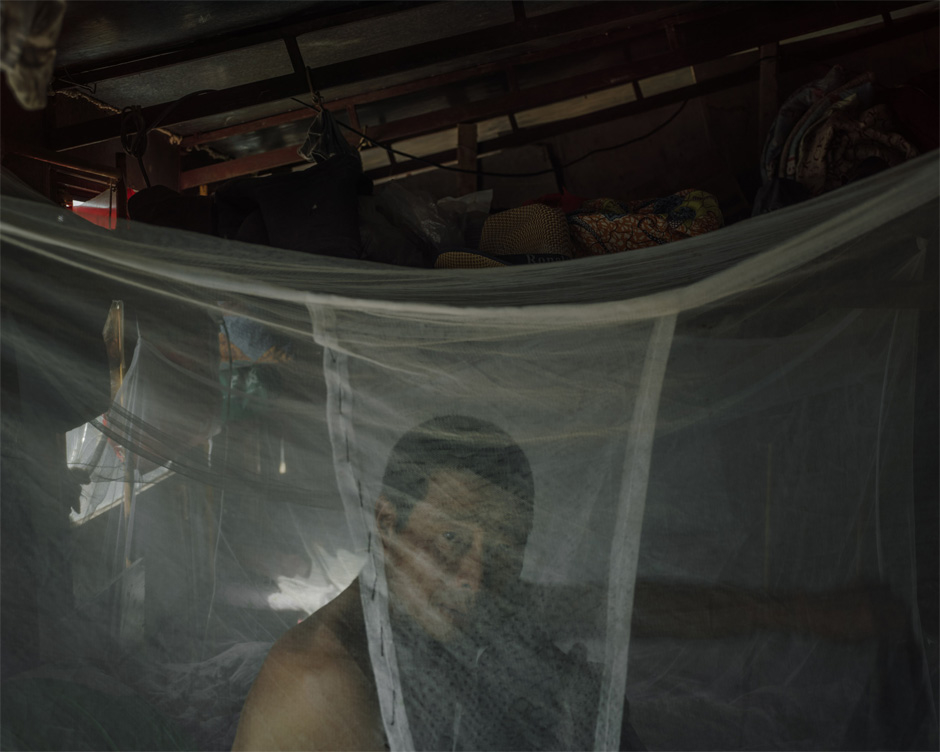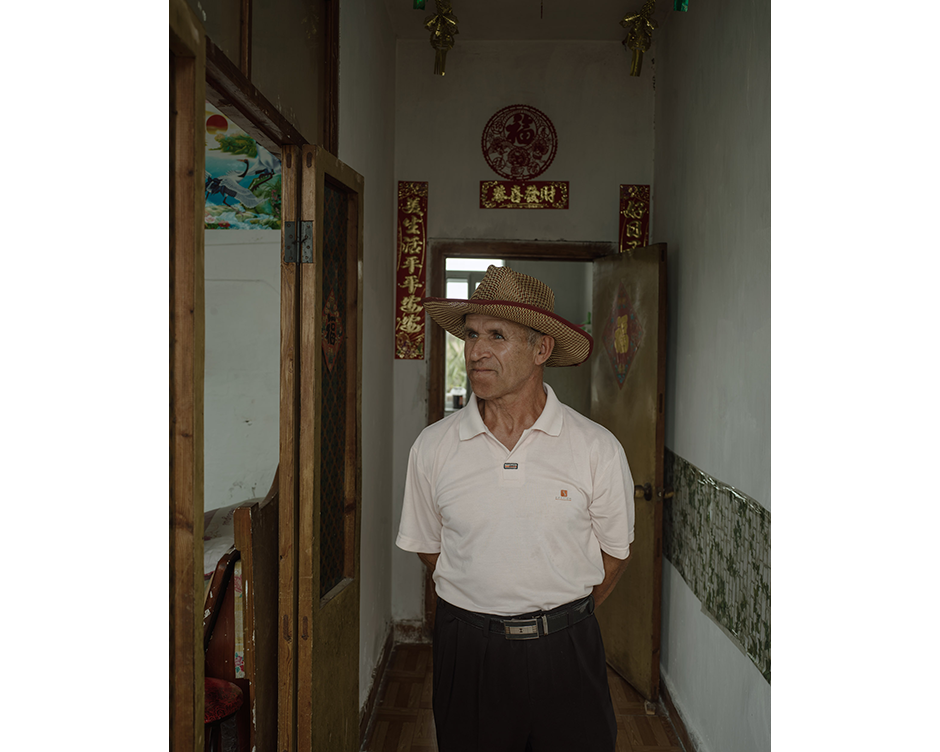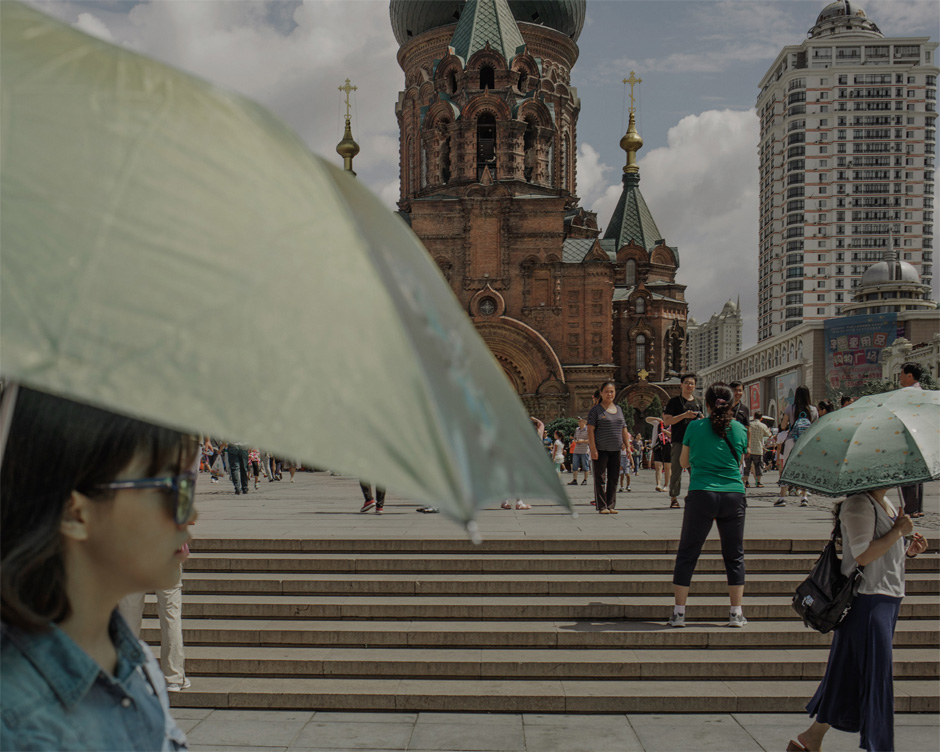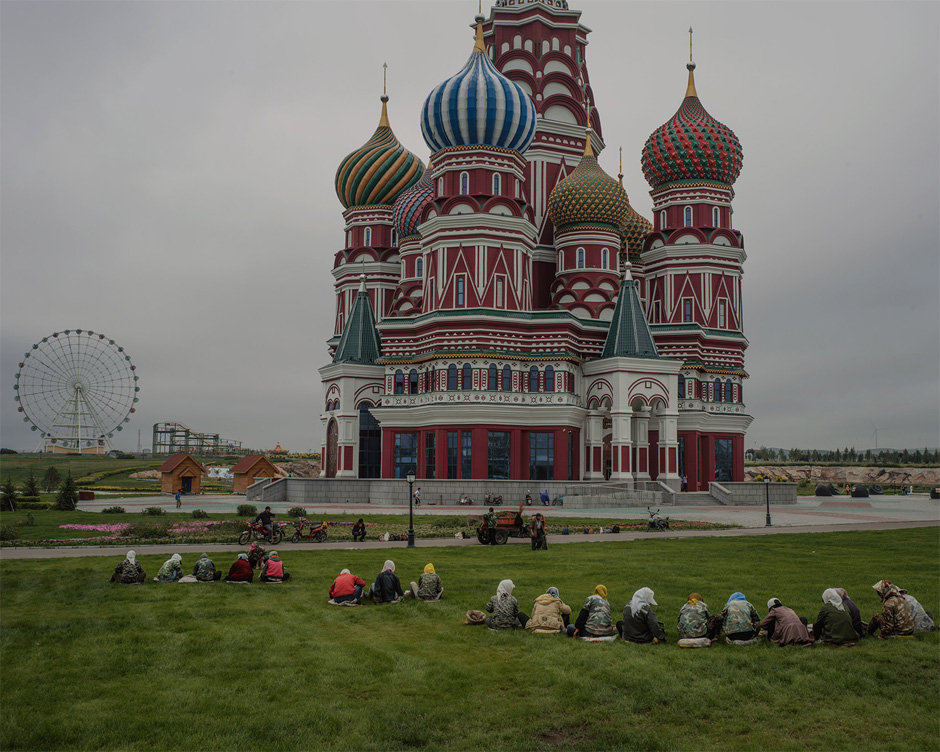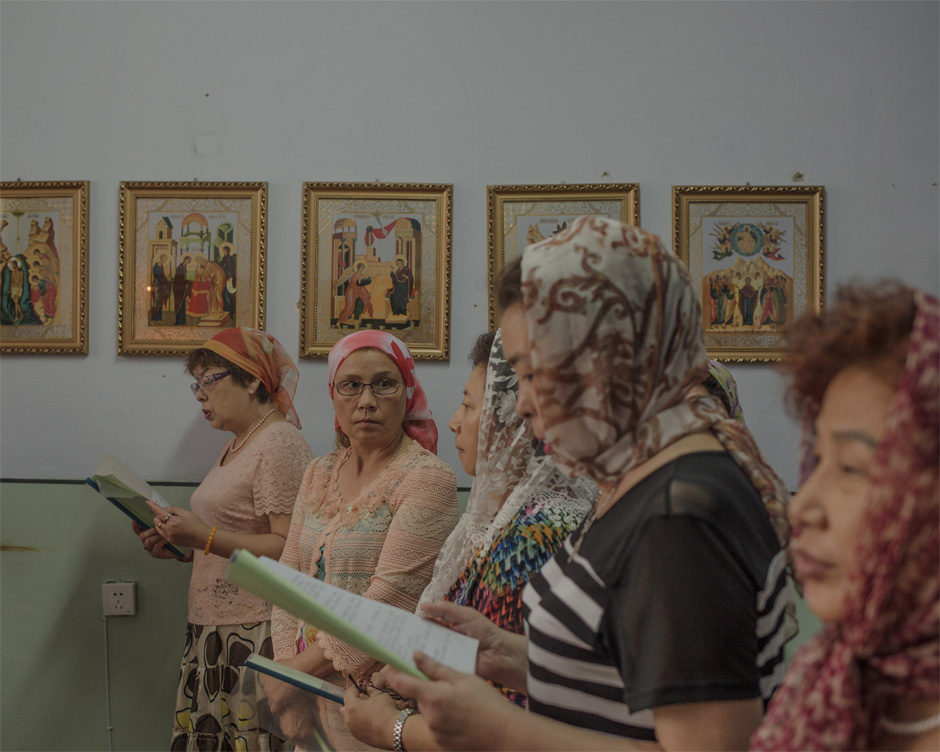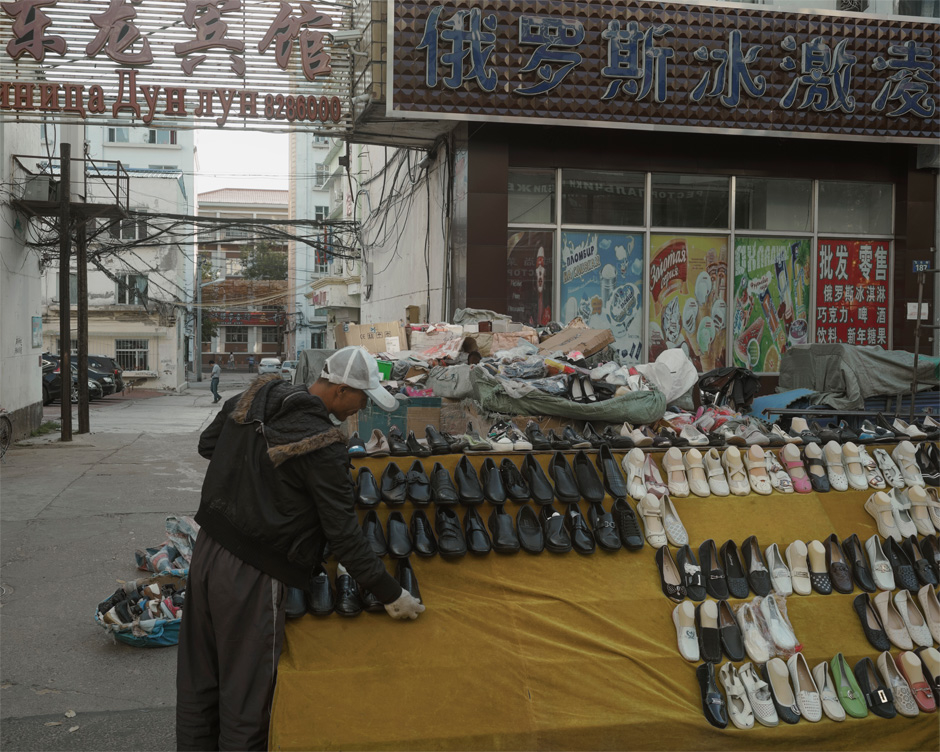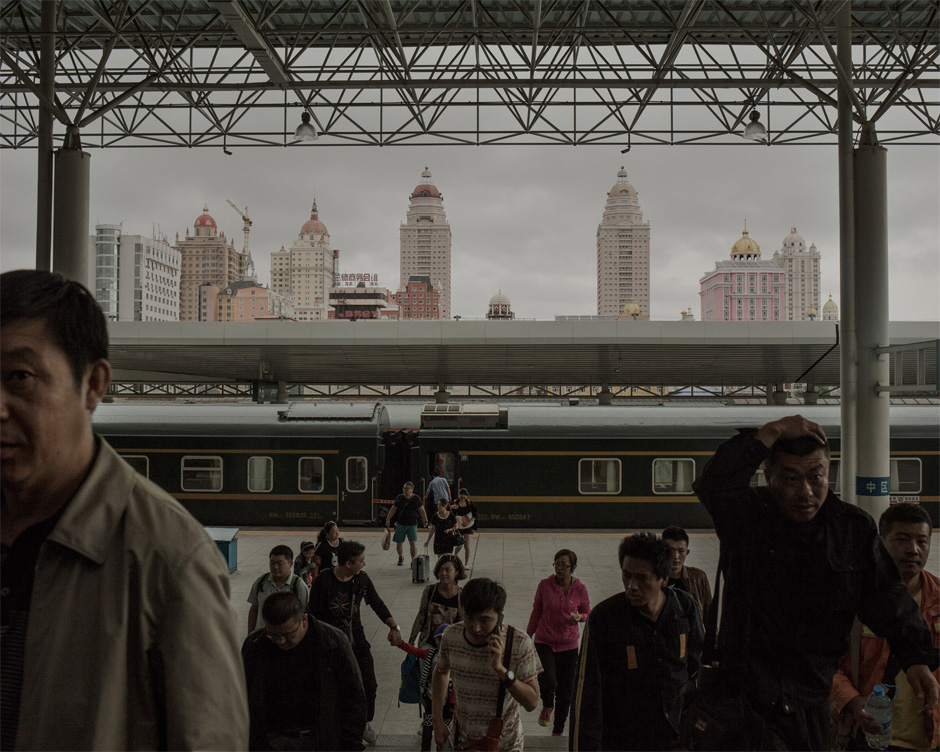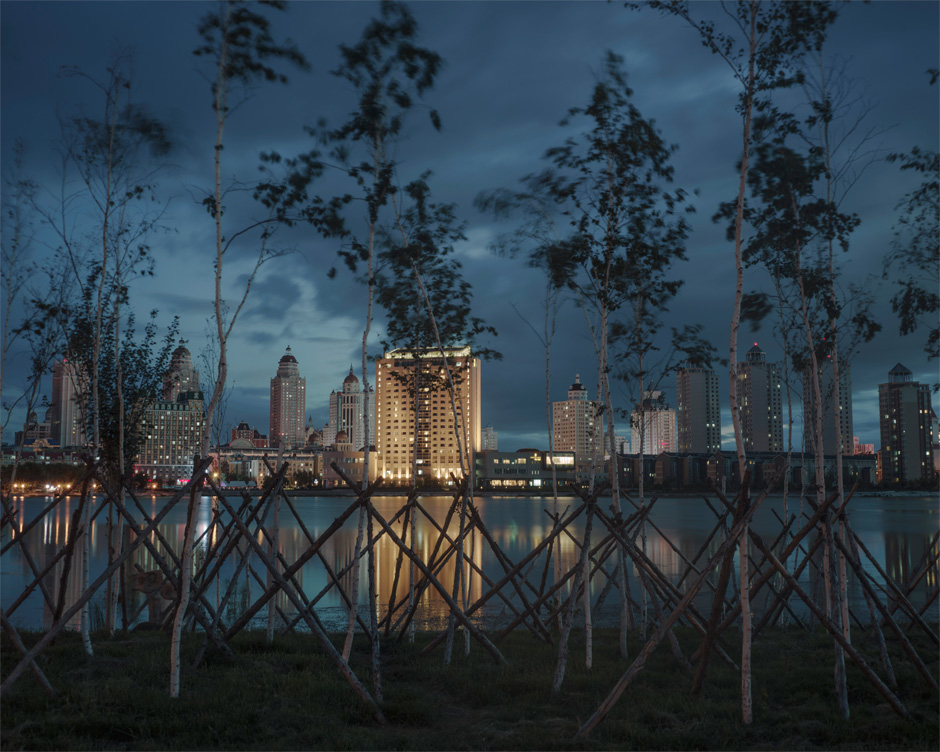It takes a brave man to jump off a moving train for the sake of a sale, but the clothes hawkers had the easy courage of men who did this on the regular. I watched as they leapt off the front carriage as the train chugged into a station with no stop, bundles of cheap Chinese jeans and jackets on their arms, exchanged hurried words and cash with waiting Russians, and jumped back on the last carriage as the Trans-Siberian trundled steadily toward Moscow from Ulaanbaatar.
They were Mongolians, but they knew enough Russian and Chinese to barter in both languages—and to flirt. After the stop, one of them came into the dining carriage where the Russian waitress, happily plump, danced with him without music, one hand turning in his and the other keeping hold of her cigarette as she moved. “Beautiful!” he said in Russian. They sat down with me, and we established the boundaries of our languages; her expansive, laughing Russian, of which I could get no more than the glimmers and he understood easily but spoke brokenly, their song-and-movie-aided understanding of my English, and the pidgin Chinese he and I shared. (This was in 2006; since then my Chinese has expanded from pidgin into harsh-voiced crow.) “English gentleman!” she said, in English, and laughed. “Chinese gentleman!” she said of the Mongolian, which he didn’t correct, adding, in Russian, what I took from the loanwords to be “Confucian gentleman, correct? Chinese are Confucians, like English are Catholics.”
A little later that day, the train pulled in for a short stop, where the bargaining could be fuller and fiercer. Russian traders were waiting in anticipation on the platform, young men and middle-aged women. The men were gopniks—skinheads in shell suits and gold rings, faces hardened by growing up in Russia’s post-apocalyptic 1990s. (Chavs, the English would say; white trash, the Americans.) The Mongolians preferred the women, for good reason. I watched as two of the gopniks argued loudly with a Mongolian. As the train was about to leave, one of them suddenly shoved the Mongolian trader violently to the ground as the other grabbed his bundle of plastic-wrapped clothes. They bolted with the speed of practiced thieves. The Mongolian leapt to his feet, yelled, and drew his knife, drawing it back over his head to throw. The crowd gasped. He threw—and it clattered uselessly on the platform, the blade only half-extended, as the train started pulling out of the station. He grabbed his knife and leapt back into the carriage and the commiserations of his comrades. I decided that if I were the thieves, I would not frequent this route for a while.
Trade made the Sino-Russian borderlands, carving a great path across Eurasia. It still shaped people’s lives: my usual driver in Mongolia, “Jack,” had bought his taxi with money earned from shuttling cars from Moscow to China in the 1990s. He went west by train and returned by road, sleeping wrapped in sheepskins in the old junkers he bought. In Budapest, my cosmopolitan grandfather Rudi Fischer walked me to a favorite haunt of his, the “Chinese Market” in Jozsefvaros, one of many grand bazaars of cheap goods shuttled through Russia to Eastern Europe, full of gaming and noodles. In the small Russian segment of Beijing around Jianguomen, every third building was labeled “KARGO.”
But the threads of friendship forged along the route, sometimes cautious, sometimes full-throated or loving, were often snapped by violence. Sometimes this was sporadic, and local; more often it was a product of the frictions between two great empires, the Russians and the Chinese, whose resemblances to each other had a magnetic quality, alternately attracting and repelling.
And once, it came close to ending the world.
* * *
Across the frozen Ussuri River that marked the boundary between China and Russia, two armies stared each other down. Soon they would clash, as they did almost every week, on the ice. The Chinese swung halberds and hooks; the Russians advanced like medieval knights with great spears, while others stood by to knock down with maces any Chinese warrior brave or lucky enough to make it through.
This was the winter of 1968, and far worse weapons were on hand, from the Type 56 rifles the Chinese carried to the tanks and BM-21s (mobile rocket launchers) in the Soviet camp to the missiles sitting in silos hundred of miles away, tipped with annihilating fire. But both the Soviet Army and the People’s Liberation Army were holding back, provoking and brawling with one another while under orders not to be the first to fire.
Anger between Moscow and Beijing was playing itself out along the border. Chinese soldiers would swim the river in summer, or scramble over it in winter, waving Mao’s Little Red Book and shouting slogans about how the Russians had stolen the territory while China was weak. Russians would push them back into the water. When the river was solid enough to fight on, both sides would send out hundreds of men to brawl, adapting medieval weaponry for their own purposes. The Russians, claimed Senior Lieutenant Vitaly Bubenin in a newspaper interview in the early 2000s, were “stocky Siberians with the huge fists of foundry workers, so the Chinese stood no chance of a win until they brought in reinforcements from Northern China.”
There was something playful about the fighting, reminiscent, for the Russians, of the “wall on wall” fights where the men of two villages would line up to whale on each other. Even the weapons were meant to hurt, not kill; both sides’ thick winter jackets took the worst of the blows. For the Chinese, making it to the other side of the river was a sport; sometimes, if the mood was good, they would offer cigarettes and copies of Mao’s writings to the Russians.
But on March 2, 1969, things became less friendly. For unknown reasons, the Chinese opened fire on a Russian patrol on Zhenbao (“Treasure”) Island, a scrap of nothing in the middle of the river. Bubenin led a desperate rescue attempt, skidding across the ice in his APC to flank the Chinese who had shot his men and rake them with machine-gun fire.
The Russians were shocked to find that most of their men had only been wounded, but had then been murdered in cold blood, shot or bayoneted at point-blank range. The rhetoric stepped up, as did the bloodshed. Chinese radio broadcasts told the Russians, “Dear Soviet comrades, temporarily residing on Chinese territory! By March 8 our great leader Mao Zedong will give his wife Khabarovsk [the regional capital, 30 miles from the border]!” and “Dear Soviet women! Starch the sheets—our men will arrive soon!” With a total of 59 of their own dead after another Chinese attack on the island on March 15, Russian retaliation unleashed a hailstorm of rockets, killing, by Soviet estimates, between 200 and 300 Chinese.
Months of tension began, punctuated by sporadic exchanges of fire. Fingers hovered over buttons. Talks that September, when Soviet Premier Alexei Kosygin visited Beijing, were held at the airport to avoid the possibility of angry Red Guards stoning his car, or worse. In Washington, the Americans took notice, and the possibility of a diplomatic coup began to take clear shape in Richard Nixon’s mind.
No war came. But fear of the Soviet Union lingered for years. In Tangshan in 1976, when the earthquake struck the city’s heart, survivors’ first thoughts were that the Russians had nuked them. The Chinese poured vast sums of money and arms into Afghanistan in the early 1980s, working alongside the Americans and the mujahedin to fill the secret flights back to the Soviet Union with the bodies of Russian boys every month.
* * *
Yet today, Moscow and Beijing are closer than they have been in nearly 70 years. Chinese media repeats the Russian nationalist narrative of events from Ukraine to Syria. A brief ambiguity over the annexation of Crimea ended up with the term “annexation” itself verboten, and the event instead referred to as “Crimea’s return to Russia,” or “the integration of Crimea into Russia,” echoing China’s revanchist ambitions in Taiwan and elsewhere. At Chinese conferences on topics from military to media, Russians are everywhere, far outnumbering Europeans or Americans. Russians are playing out China’s own patriotic fantasies; resistance to the West, reclamation of lost territories, the macho posturings of Vladimir Putin. The existing paranoia of the Chinese state about U.S. influence is being doubled by a steady drip of Russia’s conspiracy theories.
The Soviet collapse sent shockwaves through the Chinese leadership; the two had been carefully, slowly reconciling after the bitter schism in the years after Stalin’s death, which saw the Communist world split between Beijing and Moscow, and it set a terrifying precedent. The humiliation, as the Chinese saw it, of Russia in the 1990s, stripped of territory and economically crippled, seemed to echo China’s own “century of humiliation” at the hands of foreign power. Putin’s nationalism, coupled with the oil-fueled revival in Russia’s economic fortunes, makes sense to Chinese, who see in it an echo of their own ambitions. It doesn’t hurt that Russia’s ambitions are headed fortunately Westward, toward breakaway separatists like Georgians and Ukrainians, not toward Siberian expansion or Central Asian revanchism. Meanwhile, China’s quiet dropping of northerly claims contrasts sharply to its thunder around the South China Sea, where Russia has no interests.
At a state level, authoritarianism seems to be the best glue of Sino-Russian friendship. Moscow and Beijing back each other up on everything from Internet “sovereignty” to the need for brutal “anti-terror” security measures to condemnation of the endless inequities of the West. The two have just announced a shared media platform, although whether it will resemble the freewheeling conspiracy-theories and slanders of Russia Today or the numbing tedium of Chinese state media is as yet unknown.
Yet Russians are more ambivalent than their leaders. Anti-Asian racism runs deep, though mostly directed against Central Asians, and the fears of Yellow Peril and demographic overrun still seep through Russian popular media. But China’s power and money make it a tempting ally, especially as Moscow sets fire to the bridges once tenuously built to the West. Most of all, China willingly fulfils Russia’s deepest ambition on the international stage: to be treated as a great and equal power, rather than just, as the Cold War phrase witheringly went, “Upper Volta with nukes.”
* * *
It was as equals that the two empires first formally met over three centuries ago, in the small fort of Nerchinsk in 1689. They had been fighting for years, on and off, over the Amur basin, which the Qing dynasty’s ruling Manchus called home and the Russians saw as another step in their long, predestined conquest of the East. With their conquest of China solidified, the Manchus had moved in force against Russian incursions, burning forts and driving out merchants and colonists. Nerchinsk, a meeting carefully negotiated by Mongol rulers caught between the two sides, was the chance to make peace. The deal struck saw the two recognize each other as equals, with their own rights and territories, and defined the length of the border.
Both were pushing the limits of their empire there and elsewhere. Yet while the Qing envisioned a protective ring of subject states and tribes cowed into submission, the Russians saw an ever-expanding frontier. They had already conquered Siberia, and reached the Pacific. Now they were looking southward, eyeing the khanates and emirates of Central Asia.
Both claimed to be the inheritors of a great, civilized tradition far from their own homelands. To their Han subjects, the Qing pitched themselves as the rightful holders of the Mandate of Heaven, guardians of Confucian orthodoxy and social order. Yet at the same time they were khans, masters of the horse, gun, and bow, heirs of Genghis Khan and the righteous protectors of Buddhism.
The Russians were heirs to Byzantium and to Rome. Moscow, also built on seven hills, was the Third Rome, after the city itself and Constantinople, ruled by their king-emperor, whose very title came from Caesar. That Tsar—or, as Peter the Great preferred to be called, Emperor of All the Russias—was pushing them to be a great European power, shaving his boyar’s beards and chastising them for their Mongol ways. But the pull of the east spoke to that same heritage the Tsar was asking them to abandon. Their conquests were both reclamation of their rightful heritage and a civilizing mission, bringing the ways of Christianity and Europe to the backwards people of the East.
The Chinese and the Russians shared the language of empire. They did not, however, share an actual language. The meeting was arranged by Mongols, but negotiated through Jesuits, resident missionaries and scholars at the Qing court who conversed, mostly amiably, in Latin with their educated Russian counterparts. At the mouth of the Argun, a stele recorded the result in Russian, Mongol, Manchu, Chinese, and Latin; on each side of the border stones marked the limits of control, emblazoned with an Orthodox cross on the Russian side and the Manchu for “border” on the Qing.
* * *
It was the follow-up treaty, signed in Kyakhta—now on the border of Russia and Mongolia—in 1727, that both cemented and limited Sino-Russian trade. Caravans would be allowed into Beijing every three years, better terms than for any other Western power at the time. Kyakhta itself, a Russian fortress town of a few hundred people, would be one of only two sites allowed for cross-border trade; the other, at the far northeastern Tsuruhai Tui, never flourished.
Kyakhta did. On the Chinese side, Kyakhta became Maimaicheng, “Buy-Sell Town,” a common name for Chinese trading settlements. There was another Maimaicheng on the edge of the monastic Mongolian capital of Urga, today’s Ulaanbaatar, another stop on the long “tea road” that ran from Beijing all the way to Europe. Trade increased 64-fold over the next century, Russian furs for Chinese tea. Fujian families ran refined tea for European snobs, buying sea otter fur and European textiles for sale back home. For coarser palates, the bulk of the trade went in tea bricks, the standard currency of merchants—fearing a loss of scarce silver, the Russians forbade currency trade until 1854.
Kyakhta was an ugly mix of squalid border poverty and grand projects, topped with the stone houses of the richest merchants. As traders crossed between the two towns, separated by only a dirt road, they passed under the Kyakhta gate, with its vast two-headed imperial Russian eagle, and into the shadow—literally—of the Russian church. The Church of the Resurrection was the second richest in the Russian empire, its doors made of two thousand pounds of solid silver. (They would, unsurprisingly, be stripped by later revolutionaries.)
Although they lived in different towns, technically, the Russian and Chinese communities of Kyakhta were deeply intermingled. They maintained offices in each other’s territory, and fought fires and caught burglars together. Sometimes, though not often, they married each other, while Chinese began to cross the border to worship an Orthodox god. They devised their own language, Kiatkha Pidgin, or learned the others’ language, or turned to Buryats or Mongols for translation aid.
Not all trade passed under Kyakhta’s eagle gates. The border was vast, poorly patrolled, and porous. Cossacks, Buryats, and Mongols crossed virtually at will between the two sides, bringing their own small caravans with them, and hooking back into Russian or Han Chinese trade networks as they needed. But the town’s good times were limited. By the 1860s, the increased speed and slashed costs of shipping had crippled the Tea Road, as had the growing quality of Indian tea. Trade shifted southward, and Kyakhta’s coffers shrunk. Both powers, however, would have more on their hands than the decline of one town.
* * *
The treaties had promised limits to empire, and civilized treatment of each other’s people. But as Qing strength had collapsed, humiliated by British warships and opium and swallowed by the ravenous black hole of the Taiping Rebellion (1850-1864), Moscow weighed the balance of power and found China wanting. Between 1858 and 1860, Russian diplomatic threats, backed up with troop movements, saw one of the most unequal treaties ever imposed, as the Qing handed over 350,000 square miles of territory once guaranteed as theirs at Nerchinsk into Russian hands without the loss of a single Russian soldier.
It was rage at foreign power, Russian and Western, wielded over a weakened China, and fearful rumors of Christian atrocities, that drove the next round of killing. In 1900, Fang Zhihai was 48, and had been an Orthodox Christian all his life, baptized in childhood at the Russian Mission in Beijing. The Mission had been guaranteed—though limited—by the 1727 treaty, and nurtured by Russian Orthodox priests who often shared the same commitment to Chinese learning that had made the Jesuits famous. Fang straddled two worlds; in one he was Zhihai, in the other Innokenty. A teacher and singer, he was preparing to be ordained as a deacon. Orthodox priests can marry, and Fang and his wife, another Chinese convert known as Elena, had four children, two teenage sons and two small girls.
Innokenty was stoned to death by Boxer rebels in the well by his church; his wife and daughters burnt alive in the house of the Orthodox priest, along with a dozen others, another son murdered somewhere on the streets of Beijing. One son survived to tell the story of his martyrdom. Innokenty, Elena, and the children were listed among the 220 Orthodox Holy Martyrs of China. “By the purity of your Christian ways,” the Russian prayer for them goes, “you put to shame the false Confucian piety and trampled demon-inspired Buddhism underfoot, sanctifying the land of China with your blood.”
Nobody, to the best of my knowledge, recorded the names of any of the five thousand or more Chinese civilians dragged from their homes by Russian troops and civilians in the border town of Blagoveshchensk later that summer, although Victor Dyatlov, a professor at Irkutsk State University, has skilfully compiled the account of their tragedy.
Like Kyakhta, it was a boom town, numbering some 50,000 Russians and perhaps 10,000 Chinese, most of them servants. “They often learned the Russian language, and approached this undertaking with such diligence—they would often sit with a Russian book or exercises until past midnight, and this zeal secured them rapid results. But among the less literate of our countrymen the Chinese never enjoyed any great popularity. Common folk viewed them, first and foremost, as representatives of a foreign nationality who stubbornly refused to mix with Russians . . . [and as] unwanted competitors,” wrote a Russian witness.
Boxer troops had shelled the Russian side of the border, boats had been sunk, and an incompetent military governor could do nothing to stem growing Russian paranoia that the Chinese in the city were a fifth column. Families looked at their once-trusted servants, wondering about poison in the tea or a door opened in the dark. Chinese began to be attacked in the street by mobs, who blamed them for lost work from trade ruined by the fighting.
By July 3, it was obvious a pogrom was about to begin. The authorities issued feeble injunctions not to harm or insult the Chinese, and then the governor received a telegram from Alexander Kuropatkin, the infamously Asian-loathing Russian Minister of War, urging the “total defeat” of the Chinese. The order was given to “expel” all the Chinese. Some had fled, but several thousand had stayed, believing the guarantees of the authorities.
They were marched to the Amur (or Heilongjiang) River, the border between the two countries. Stragglers were hacked down by axe-wielding militia or ridden down by Cossacks. At the river, raging in summer torrent, they were ordered in. When the first drowned, the others refused, and then the shooting began, until the last few survivors were forced in by a bayonet charge. It was not the only massacre. “Regarding killing the Chinese . . . you must be mad to keep asking permission each time . . . when you are ordered to kill them, then you should get on and kill them without any further discussion,” the regional governor wrote.
Even after the Boxer Rebellion had been put down, Russian fear of the Chinese continued to grow. As historian Willard Sunderland traces, Russian administrators, who had once seen Chinese labor as an easy answer to their construction needs, became increasingly paranoid about the threat of “yellow labor.” From 1907 to 1913, in a Russian parallel to America’s racist legislation of the 1880s, harsh laws were passed to “defend the region against the onslaught of the yellow race.” N. L. Gondatti, the Russian regional governor, commented, “I’d rather see our lands go empty than be occupied by the yellow race.” Foreign labor was banned from state projects, and Asians were driven into “Chinatowns” and “Koreatowns” by zoning laws. Communities that had once thrived from cultural exchange were increasingly characterized by mutual paranoia.
* * *
It was Stalin who made life better. In Siberia, the Chinese population, brutally persecuted in late Tsarist times, was one of the few ethnic minorities not to suffer in the 1920s and 1930s—at least, no more than Russians did. The Soviets hemmed and hawed about the Chinese Communist Party more than ideology would have suggested, but the Chinese themselves, many stranded across the border by revolution and war, were never the target of Soviet policy, while the first Romanization system designed for Chinese, Latinxua Sin Wenz, was devised by Soviet Sinologists. In stark contrast was the treatment of Vladivostok’s Koreans, seen as potential agents for Japan and brutally deported to the frozen wastelands of Central Asia.
On the other side of the border, the influx of White anti-Bolshevik refugees after the 1917 revolution gave new life to the Russian community in China. The city of Harbin buzzed with exiled intellectuals, noblemen, and businessmen; the fallen Russian princess, now a high-class courtesan, became a Shanghai cliché. Harbin’s department stores were packed with Russian goods, its streets lined with churches and tearooms; the exiles’ daughters debuted at balls and picnicked on the river.
The Jewish community, strongly represented among the refugees, exploded from 500 people in 1903 to over 10,000 people and two synagogues in the 1920s, as the city flooded with refugees from the Russian revolution. Chinese found anti-Semitism baffling, and imposed, unlike Europe, no special limitations on Jewish refugees; two decades later Shanghai would provide a similar visa haven for tens of thousands of survivors. But Russian hatreds reached all the way to Mongolia, where White general and lunatic mystic Roman Ungern-Sternberg conducted a brutal pogrom in 1921; Harbin’s many White and Jewish papers buzzed with tales of his atrocities.
Harbin’s Jews got on better with their Chinese neighbors, in general, than did the other Russians, who were often notoriously contemptuous of the Chinese they lived among. They thought Japan—that power great enough to beat even Imperial Russia—was the side to bet on; Harbin residents lined the streets to cheer Japan’s invading Kwantung Army into the city in 1932, and young men trained in a specially established cadet school in Tianjin to be the administrators of a Russia they thought would be “liberated” by the Japanese. In 1946, though, they cheered for the arrival of Soviet troops—only to see their parents and grandparents who had fought against the Bolsheviks in the revolution shipped back to Moscow for execution. The vast majority of the remaining Russian community departed, in dribs and drabs, in the early 1950s, as the P.R.C. made it clear they had no home left there.
* * *
Today the Chinese press endlessly praises Russia and Putin, while the Russian press, less bound to a strict official line, occasionally returns the favor. All the State media articles in the world, however, mean little set next to Hollywood and Harvard. Chinese don’t watch Russian TV, don’t go to Russian movies, don’t sing Russian songs or try to get into Russian universities.
The two fluent Russian speakers I know from China, sent by provincial exchange programs to study in Moscow, both returned hating the country, embittered by daily racism and jealous of their classmates who went to the West. While a few hundred thousand shuttle between countries, the cultural impact of the two powers on each other is next to nothing. There are 12 times as many Chinese living in Vancouver as in all of Russia. Searching for “America” on Chinese social media returns 55 times as many results as “Russia.”
Russians still worry that China wants Siberia. But nobody of consequence in China dreams of life on the cold frontier. Finding Chinese labor is hard enough that recruiters often resort to fraud, promising far higher wages than will ever be delivered, or even end up locking them as virtual slaves in isolated farms and villages, threatening their families if they try to escape. The borderlands are left, as so often, to the small and the powerless.




